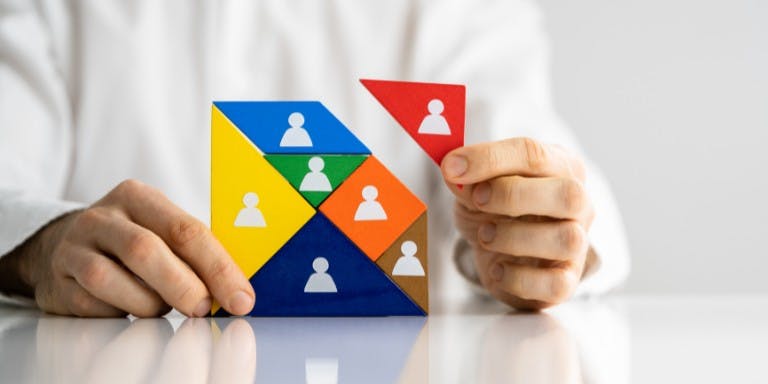First published on Thursday, June 20, 2024
Last updated on Tuesday, March 25, 2025
Jump to section
From time savings to the discovery of high-value insights, HR software brings numerous business benefits. With centralised databases and talent management functions, such systems allow for more effective HR work.
It’s common to hear acronyms like HRIS, HRMS and HCM when shopping for HR software and you may wonder if there are any differences between them, and which system is best for your business.
In this article, we're clearing up any confusion by looking into the different types of HR software and the associated features and benefits. Keep reading to discover how the three main types of HR software can help your business.
HRIS software
A Human Resource Information System (HRIS) is a tool for collecting and storing employee data. You could simply think of it as a digital filing cabinet—where instead of having scattered paper documents, you have a well-organised central system.
The following features come as standard with most types of HRIS systems software:
Employee database
Performance management tools
Recruiting and applicant tracking
Reporting & analytics
Manager and employee self-service portal
Document management and storage
Integrations with software and systems
The HRIS is a single source of truth, commonly including modules for recruitment, performance management, learning, and development. With such data kept in one central place, decisions can be made much faster.
HRIS integration may help business owners in the following ways:
Automating administrative tasks with accuracy and speed
Enabling the maintenance of up-to-date records for compliance
Enhancing the security of employee records
HCM software
A level up from the HRIS, a Human Capital Management (HCM) system is generally recommended for medium-scaling and large businesses. It includes all of the elements available to HRIS users. Plus, there's functionality for tracking employee training, development and talent management. This usually means that HCMs are equipped to handle the entire employee lifecycle.
You might think of the HCM as a head chef—selecting, preparing, and combining the best ingredients (talent) for a boost of team performance.
Specific HCM functionalities include:
Onboarding
Performance
Position control
Succession
Salary planning
Analytics
HCM platforms often support global operations with multi-currency and country-specific formatting. However, their payroll is usually transferred to third-party accounting software.
HCM integration may help business owners in the following ways:
Digitally screening and assessing candidates for a reduced time to hire
Enabling the sharing of documents, training modules, and company policies with new recruits
Supporting the analysis of workforce data for insights into employee turnover, productivity, and engagement
Using predictive analytics to forecast staffing needs and anticipate potential HR issues
HRMS software
The Human Resource Management System (HRMS) evolved from the HRIS in the early noughties. As a more comprehensive platform, the HRMS combines a range of key HR functions into one combined suite.
You might liken it to an orchestra conductor—ensuring that HR functions such as recruitment, payroll, and training work in harmony as part of a seamless and efficient process.
The following advanced features are often included in the HRMS software:
Employee engagement platform
Employee satisfaction surveys
Custom workflow tools
Built-in training tools
Generally speaking, the HRMS includes the functionality of the HRIS plus the HCM; with payroll and talent management rolled in. However, this isn’t true for all HRMS platforms.
Here are a few ways that an HRMS could benefit your business:
Enabling the analysis of recruitment data to identify effective advertising channels and improve hiring quality
Automating payroll processing for improved accuracy and faster payments
Supporting employee development through the setting of personalised learning paths and access to relevant training
Comparrison of HRIS, HRMS, and HCM software
As mentioned, there are some similarities between HRIS, HRMS and HCM systems. They each support HR in storing data specific to worker demographics, training, and performance.
However, these types of HR management systems vary in their coverage of HR functions. While an HRIS can be depended on for the management of core HR activities, an HRMS comes with a wider range of features.
For instance, an HRIS is well suited to capturing and storing worker data. However, in switching to a more advanced HRM system, you’ll be opening up the potential for greater data engagement and strategic planning. That said, the best platform choice comes down to your business needs.
It’s worth taking the time to reflect on the differences in functionality and scope before choosing your human resources information management system. Consider whether there’s a valid need for employee engagement, what your onboarding process looks like, and if talent management is a priority for your company. The answers to such questions will give you a solid bearing in making the right choice for your HR team.
Discover BrightHR’s HR Software
To recap, the benefits of an HRIS system include the central organisation of employee data, ensuring accessibility for the efficient performance of HR activities. HRMS system comes with the added benefits of enhanced data management, self-service, and support for improved decision-making. And an HMC will allow for more in-depth analytics in support of workforce planning, boosting employee satisfaction and retention.
With a clearer idea of the differences between the human resource tools, you should find making a choice much easier. Ideally, your chosen system should align with your budget, scalability needs, and strategic goals. It's bound to make a positive difference to your data management, efficiency, productivity, and the employee experience.
Combining the best elements of all three types of HR management systems, BrightHR stands out among the top HR solutions providers.
Discover our core HR software features and game-changing tools of our all-in-one HR software.










